Research on the Vibration Propagation Characteristics of Non-Uniform Speed Trains Entering and Leaving Stations Based on Field Measurements
Abstract
1. Introduction
2. Materials and Methods
2.1. A Brief Review of the Experimental Site
2.2. Experimental Instruments
2.3. Layout of Measuring Points
2.4. Vibration Evaluation Index
2.4.1. Vibration Acceleration Level
2.4.2. Maximum Vibration Level of Frequency Division
3. Results and Discussions
3.1. Analysis of Background Vibration Impact
3.2. Vibration Propagation Rules of Trains Running in Different Line Directions
3.2.1. Time-Domain Analysis of Trains Running in Different Line Directions
3.2.2. Frequency-Domain Analysis of Trains Running in Different Line Directions
3.3. Influence of Acceleration and Deceleration in and out of Subway Station on Vibration Propagation Law
3.3.1. Time-Domain Analysis of Trains Entering and Leaving the Subway Station
3.3.2. Time-Domain Analysis of Train Acceleration and Deceleration
3.3.3. Frequency-Domain Analysis of Trains Acceleration and Deceleration
3.4. Characteristics of Vibration Propagation at Different Distances from the Outer Walls of Subway Stations
3.4.1. Time-Domain Analysis of Trains at Different Distances from the Outer Walls of Subway Stations
3.4.2. Frequency-Domain Analysis of Trains at Different Distances from the Outer Walls of Subway Stations
4. Conclusions
5. Future Work
Author Contributions
Funding
Data Availability Statement
Conflicts of Interest
References
- Zhang, X. Forty years of highly synchronous development in China’s scientific research and economy. Natl. Sci. Rev. 2018, 5, 796–798. [Google Scholar]
- Sun, M.; Liu, Y. Economic growth and urban rail transit development: Evidence from China’s megacities. Transp. Policy 2021, 98, 62–72. [Google Scholar]
- Chen, J.; Xu, G. Urban rail transit systems in China: Current trends and future challenges. Cities 2023, 134, 104021. [Google Scholar]
- Wang, J.; Zhang, L. The impact of economic growth on the development of urban rail transit in China. J. Urban Plan. Dev. 2021, 147, 04021025. [Google Scholar]
- Zhang, Y.; Chen, Z. Urbanization and its impact on public transportation: Evidence from major Chinese cities. Transp. Res. Part A Policy Pract. 2022, 156, 262–274. [Google Scholar]
- Liu, W.; Lund, H.; Mathiesen, B.V. Modelling the transport system in China and evaluating the current strategies towards the sustainable transport development. Energy Policy 2013, 58, 347–357. [Google Scholar]
- Xu, Q.-Y.; Ou, X.; Au, F.; Lou, P.; Xiao, Z.-C. Effects of track irregularities on environmental vibration caused by underground railway. Eur. J. Mech.-A/Solids 2016, 59, 280–293. [Google Scholar]
- Tao, Z.; Wang, Y.; Sanayei, M.; Moore, J.A.; Zou, C. Experimental study of train-induced vibration in over-track buildings in a metro depot. Eng. Struct. 2019, 198, 109473. [Google Scholar] [CrossRef]
- Zou, C.; Li, X.; He, C.; Zhou, S. An efficient method for estimating building dynamic response due to train operations in tunnel considering transmission path from source to receiver. Comput. Struct. 2024, 305, 107555. [Google Scholar] [CrossRef]
- Liu, Q.; Li, X.; Zhang, X.; Zhou, Y.; Chen, Y.F. Applying constrained layer damping to reduce vibration and noise from a steel-concrete composite bridge. J. Sandw. Struct. Mater. 2020, 22, 1743–1769. [Google Scholar] [CrossRef]
- Li, X.; Chen, Y.; Zou, C.; Wang, H.; Zheng, B.; Chen, J. Building structure-borne noise measurements and estimation due to train operations in tunnel. Sci. Total Environ. 2024, 926, 172080. [Google Scholar] [CrossRef]
- Huang, S.; Chen, Y.; Zou, C.; Jian, S. Train-induced environmental vibrations by considering different building foundations along curved track. Transp. Geotech. 2022, 35, 100785. [Google Scholar] [CrossRef]
- Qu, S.; Yang, J.; Zhu, S.; Zhai, W.; Kouroussis, G.; Zhang, Q. Experimental study on ground vibration induced by double-line subway trains and road traffic. Transp. Geotech. 2021, 29, 100564. [Google Scholar]
- Gutowski, T.G.; Dym, C.L. Propagation of ground vibration: A review. J. Sound Vib. 1976, 49, 179–193. [Google Scholar]
- Zou, C.; Wang, Y.; Moore, J.A.; Sanayei, M. Train-induced field vibration measurements of ground and over-track buildings. Sci. Total Environ. 2017, 575, 1339–1351. [Google Scholar] [PubMed]
- Di, H.; Su, G.; Yu, J.; Xu, Y.; Xu, P.; Zhou, S. Field measurement and evaluation of vibrations inside buildings above metro tunnels. Soil Dyn. Earthq. Eng. 2023, 166, 107767. [Google Scholar]
- Forrest, J.A.; Hunt, H.E.M. A three-dimensional tunnel model for calculation of train-induced ground vibration. J. Sound Vib. 2006, 294, 678–705. [Google Scholar]
- He, C.; Jia, Y.; Zhou, S. Semi-analytical method for calculating ground vibrations from a tunnel in a homogeneous half-space with an irregular surface. J. Sound Vib. 2024, 591, 118615. [Google Scholar]
- He, C.; Zhou, S.; Guo, P.; Di, H.; Zhang, X. Analytical model for vibration prediction of two parallel tunnels in a full-space. J. Sound Vib. 2018, 423, 306–321. [Google Scholar]
- Qiu, Y.; Zou, C.; Hu, J.; Chen, J. Prediction and mitigation of building vibrations caused by train operations on concrete floors. Appl. Acoust. 2024, 219, 109941. [Google Scholar]
- Zhang, J.; Xi, C.; Sun, Y.; Li, G.; Liu, J.; Wang, M. Analysis of antideformation and antivibration effect of different track beds under subway train vibration. Shock Vib. 2022, 2022, 4814039. [Google Scholar]
- Tao, Z.Y.; Zou, C.; Yang, G.R.; Wang, Y.M. A semi-analytical method for predicting train-induced vibrations considering train-track-soil and soil-pile-building dynamic interactions. Soil Dyn. Earthq. Eng. 2023, 167, 107822. [Google Scholar]
- Hu, J.; Zou, C.; Liu, Q.; Li, X.; Tao, Z. Floor vibration predictions based on train-track-building coupling model. J. Build. Eng. 2024, 89, 109340. [Google Scholar]
- Shi, W.; Bai, L.; Han, J. Subway-induced vibration measurement and evaluation of the structure on a construction site at curved section of metro line. Shock Vib. 2018, 2018, 5763101. [Google Scholar]
- Huang, Q.; Li, P.; Zhang, D.; Huang, H.; Zhang, F. Field measurement and numerical simulation of train-induced vibration from a metro tunnel in soft deposits. Adv. Civ. Eng. 2021, 2021, 6688746. [Google Scholar]
- He, C.; Zhou, S.; Guo, P. An efficient three-dimensional method for the prediction of building vibrations from underground railway networks. Soil Dyn. Earthq. Eng. 2020, 139, 106269. [Google Scholar]
- Lei, X.; Jiang, C. Analysis of vibration reduction effect of steel spring floating slab track with finite elements. J. Vib. Control 2016, 22, 1462–1471. [Google Scholar]
- Zou, C.; A Moore, J.; Sanayei, M.; Wang, Y.; Tao, Z. Efficient impedance model for the estimation of train-induced vibrations in over-track buildings. J. Vib. Control 2021, 27, 924–942. [Google Scholar]
- Jin, H.; Wang, H.; Li, Z.; Zhou, X. Vibration-reduction optimization of the point-supporting floating-slab track based on local resonance mechanism. J. Vib. Control 2023, 29, 1176–1190. [Google Scholar]
- Kong, G.; Sun, G.; Liu, H.; Li, J. Dynamic Response of Ballastless Track XCC Pile-Raft Foundation under Train Axle Loads. J. Test. Eval. 2021, 49, 1691–1704. [Google Scholar]
- Tao, Z.; Zhang, D.; Tu, D.; He, L.; Zou, C. Prediction of train-induced ground-borne vibration transmission considering parametric uncertainties. Probabilistic Eng. Mech. 2025, 76, 103731. [Google Scholar] [CrossRef]
- Li, X.; Chen, Y.; Zou, C.; Chen, Y. Train-induced vibration mitigation based on foundation improvement. J. Build. Eng. 2023, 76, 107106. [Google Scholar] [CrossRef]
- Xu, D.S.; Zhao, Y.M.; Liu, H.B.; Zhu, H.H. Deformation Monitoring of Metro Tunnel with a New Ultrasonic-Based System. Sensors 2017, 17, 1758. [Google Scholar] [CrossRef] [PubMed]
- Zhou, S.; He, C.; Guo, P.; Yu, F.; Di, H. Dynamic response of a segmented tunnel in saturated soil using a 2.5-D FE-BE methodology. Soil Dyn. Earthq. Eng. 2019, 120, 386–397. [Google Scholar]
- Deng, L.; Liu, W.; Liu, W.; Meng, M. Computation and analysis of evaluation indicators of environmental vibration induced by urban rail transit. Urban Rapid Rail Transit 2017, 30, 40–45. [Google Scholar]
- Li, X.; Zheng, B.; Chen, Y.; Zou, C. A hybrid methodology for estimating train-induced rigid foundation building vibrations. Constr. Build. Mater. 2025, 460, 139852. [Google Scholar] [CrossRef]
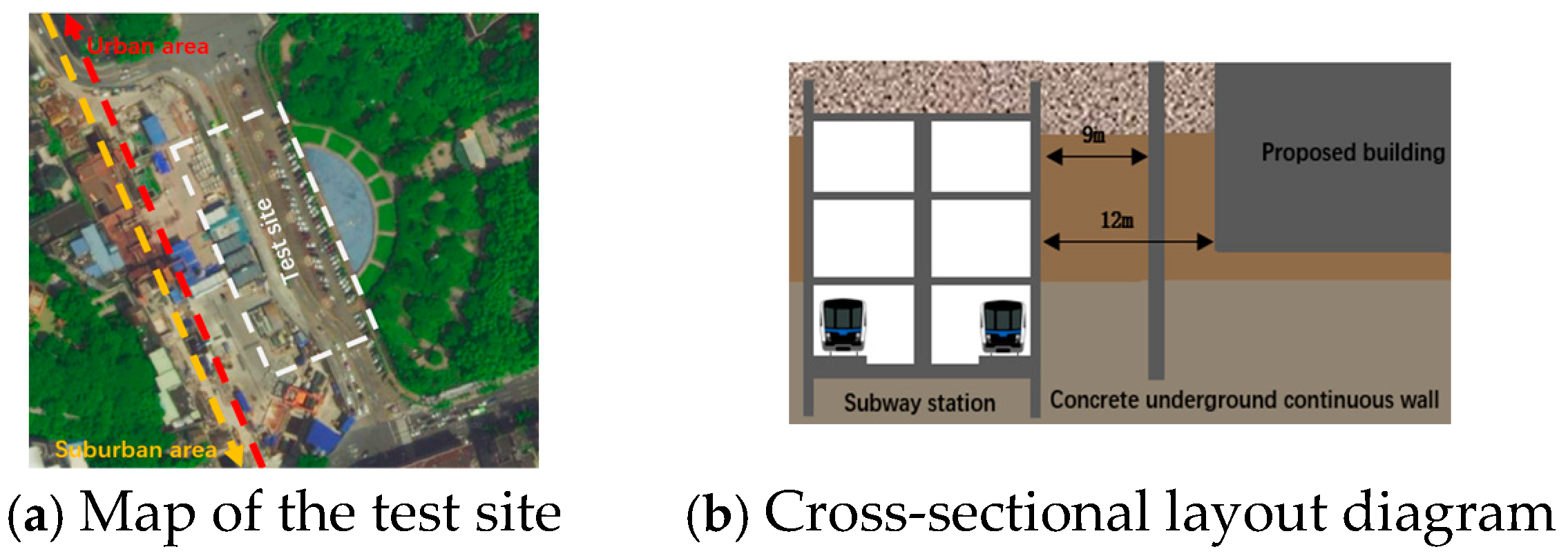


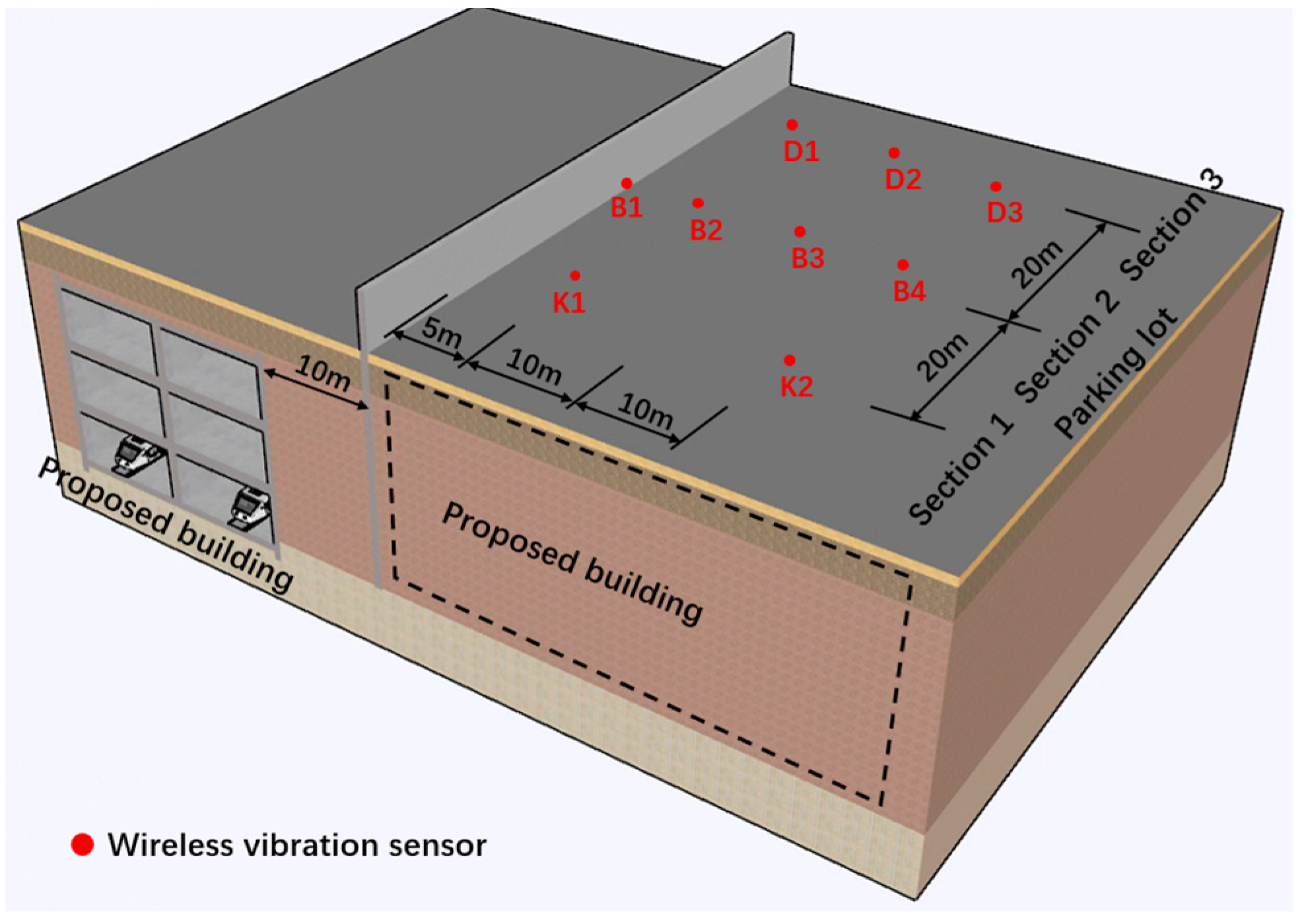

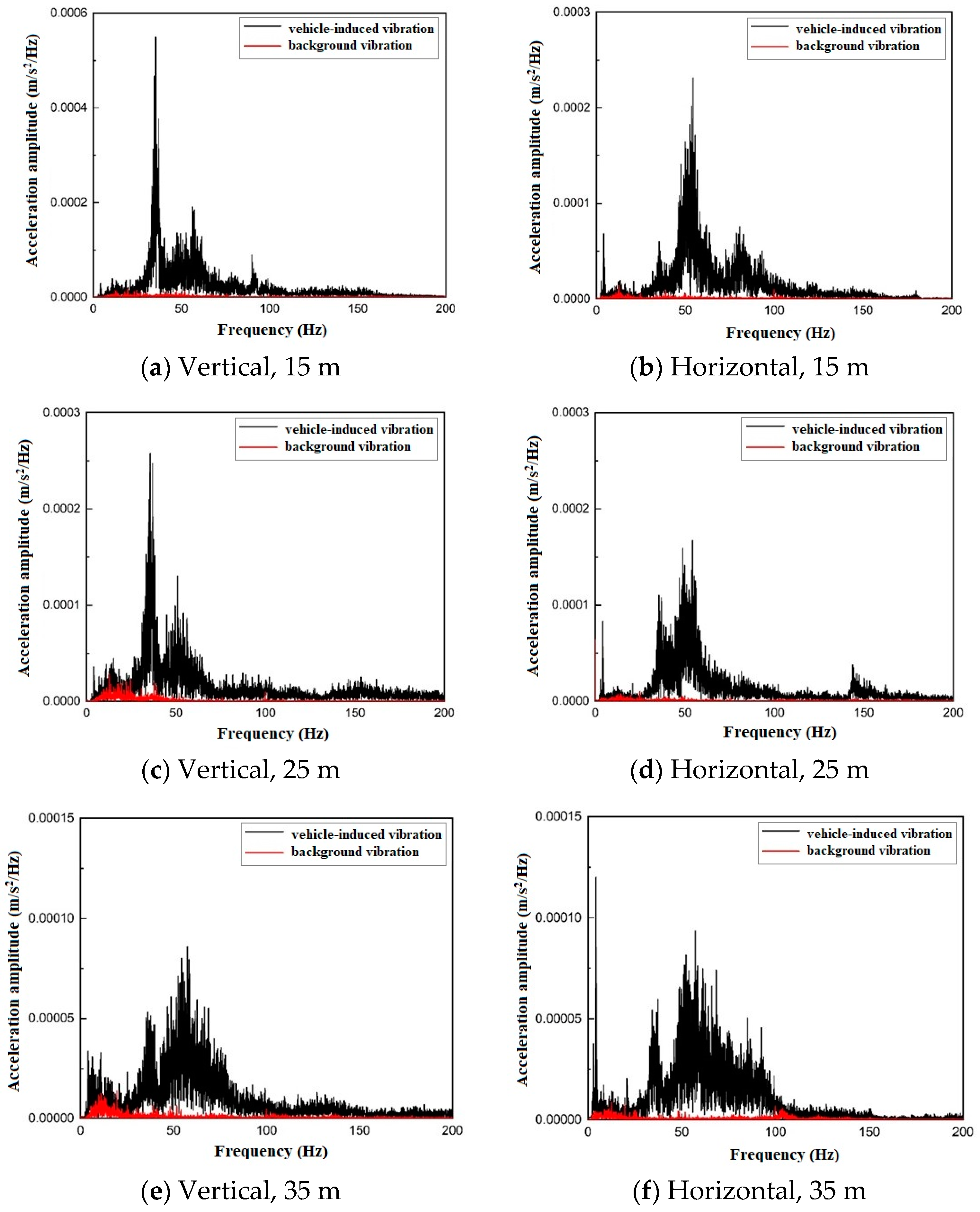

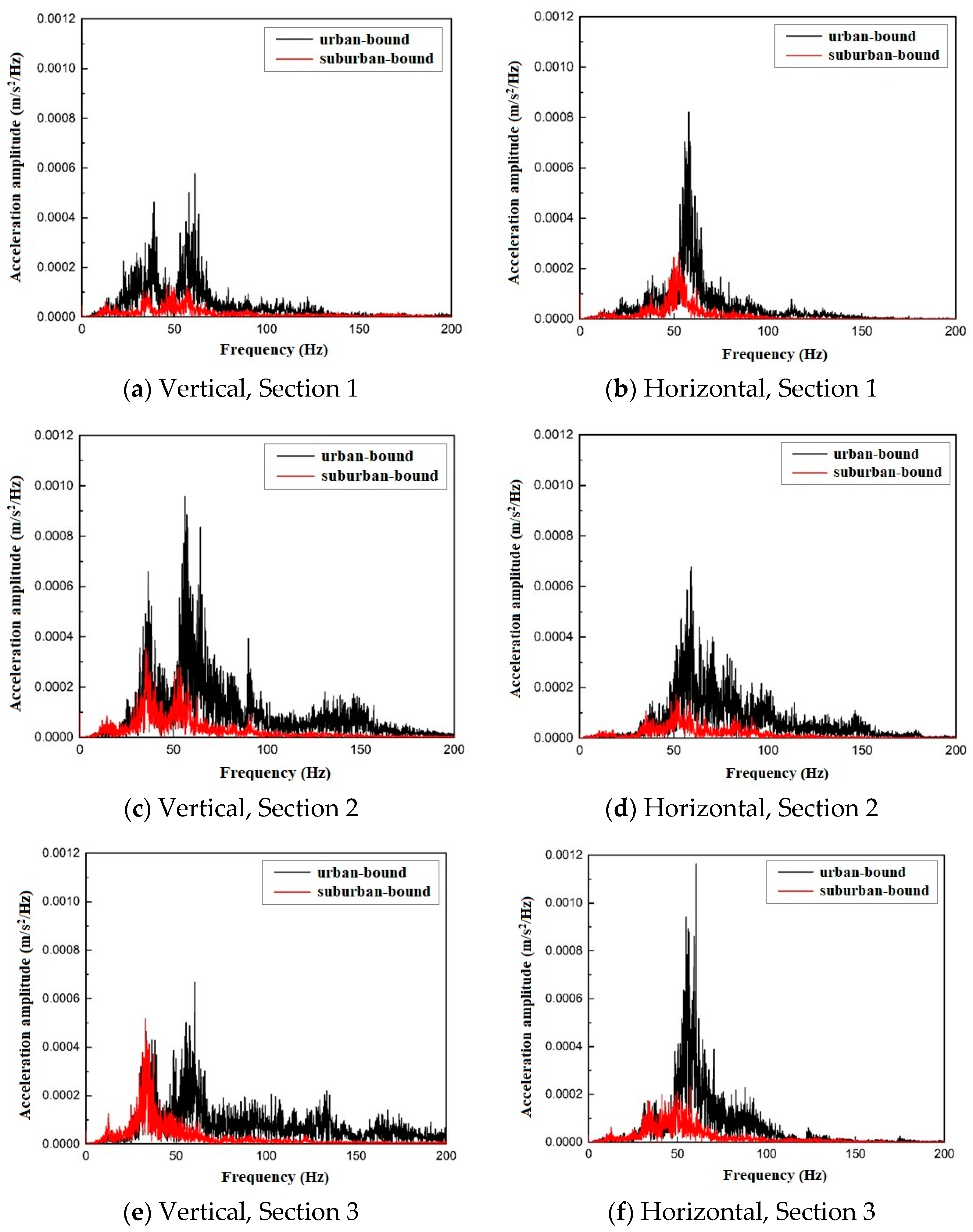

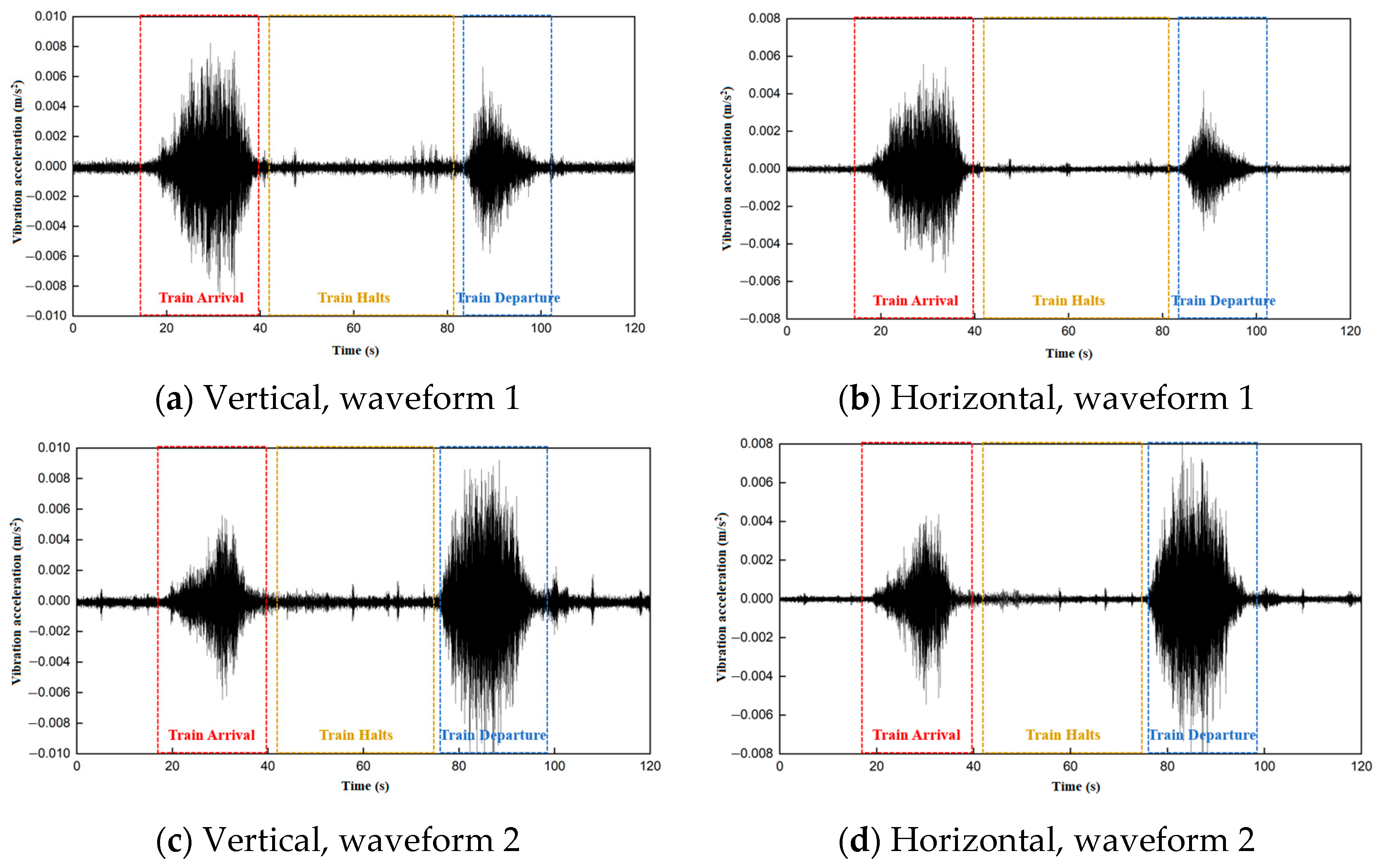

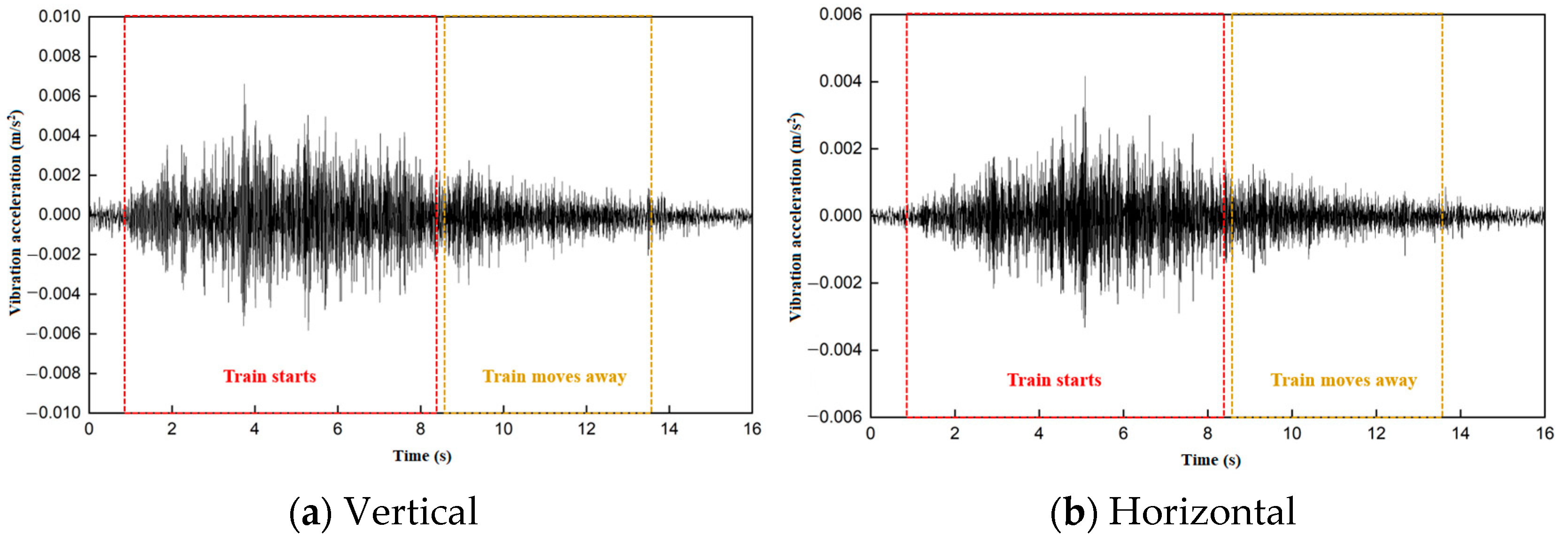
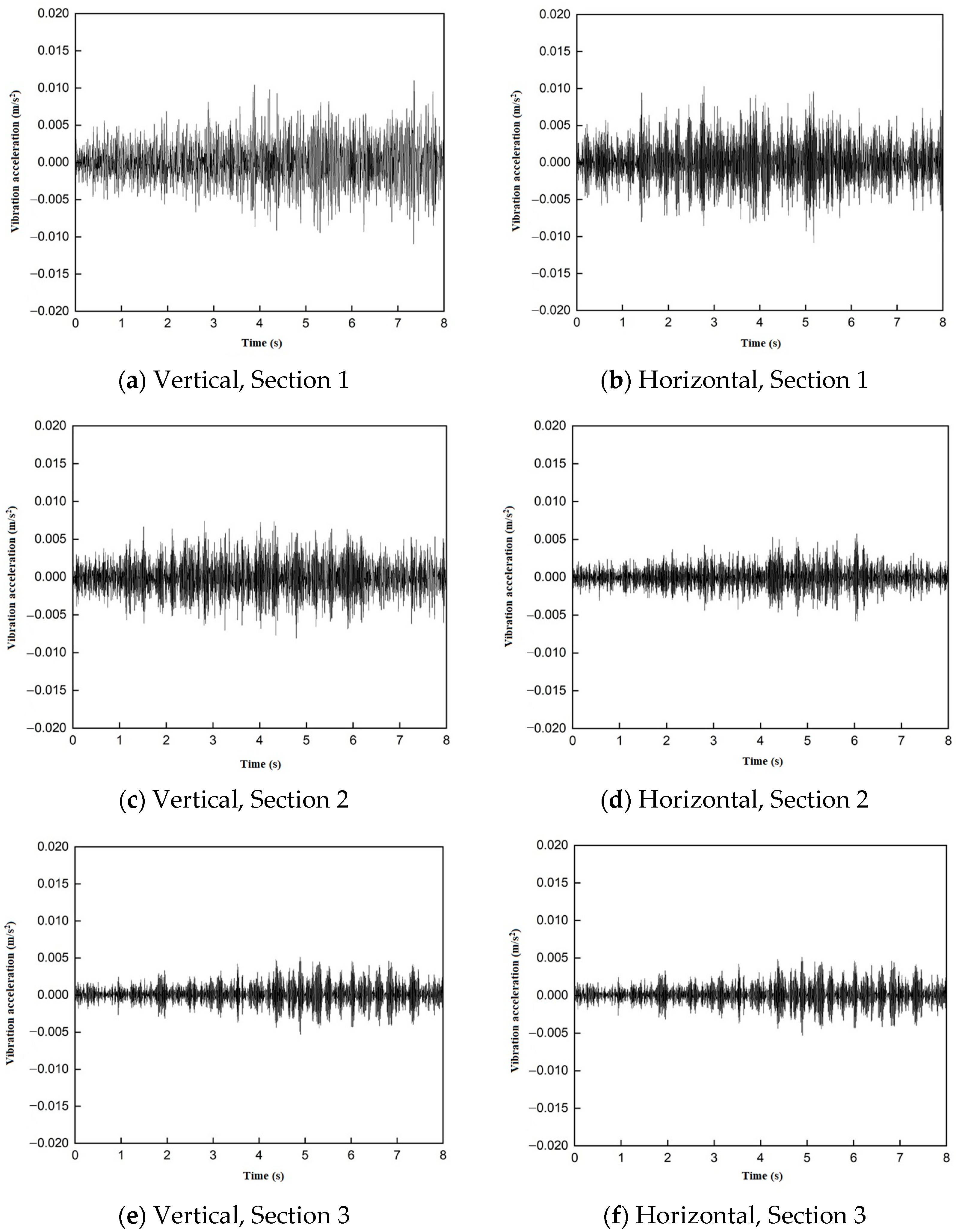
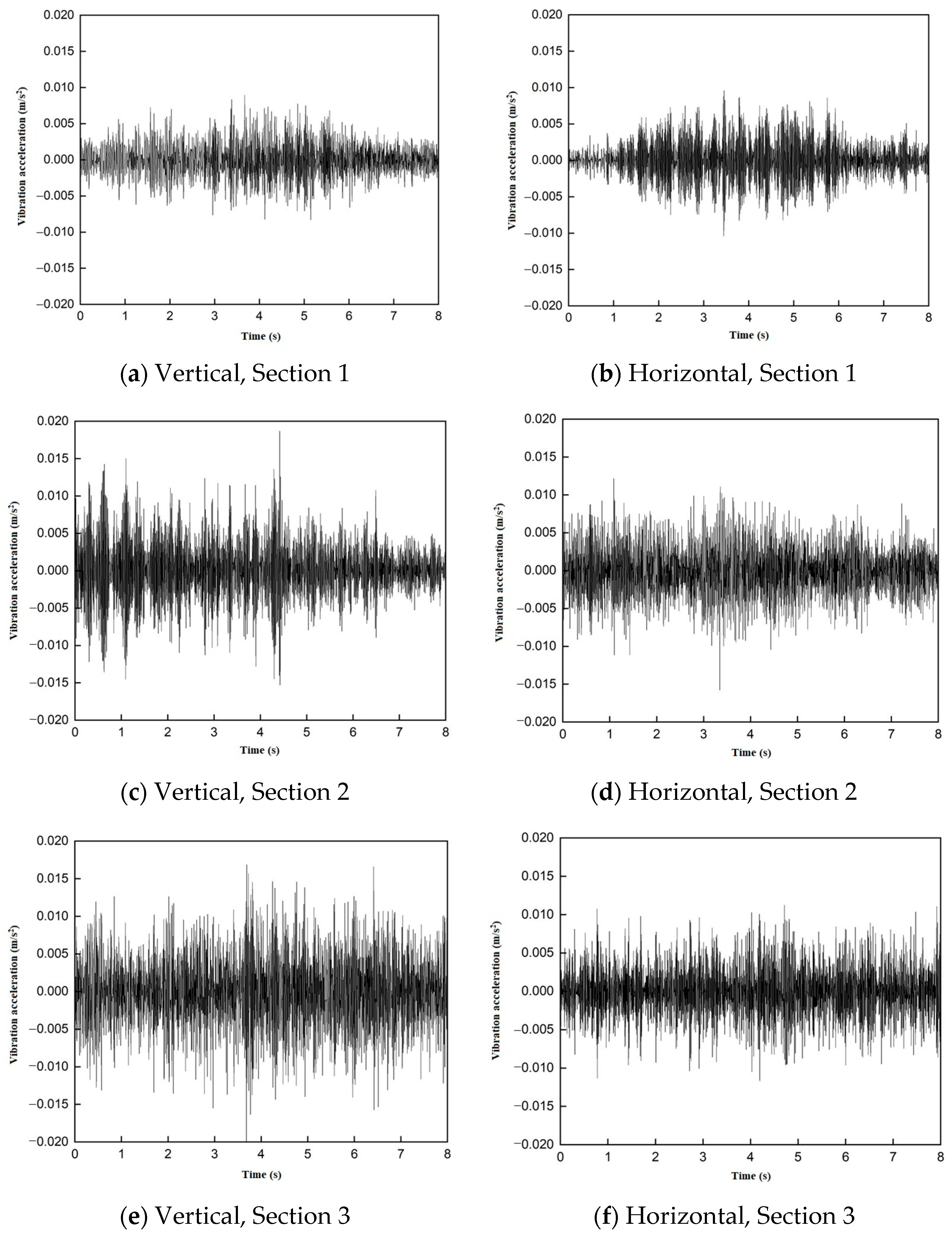

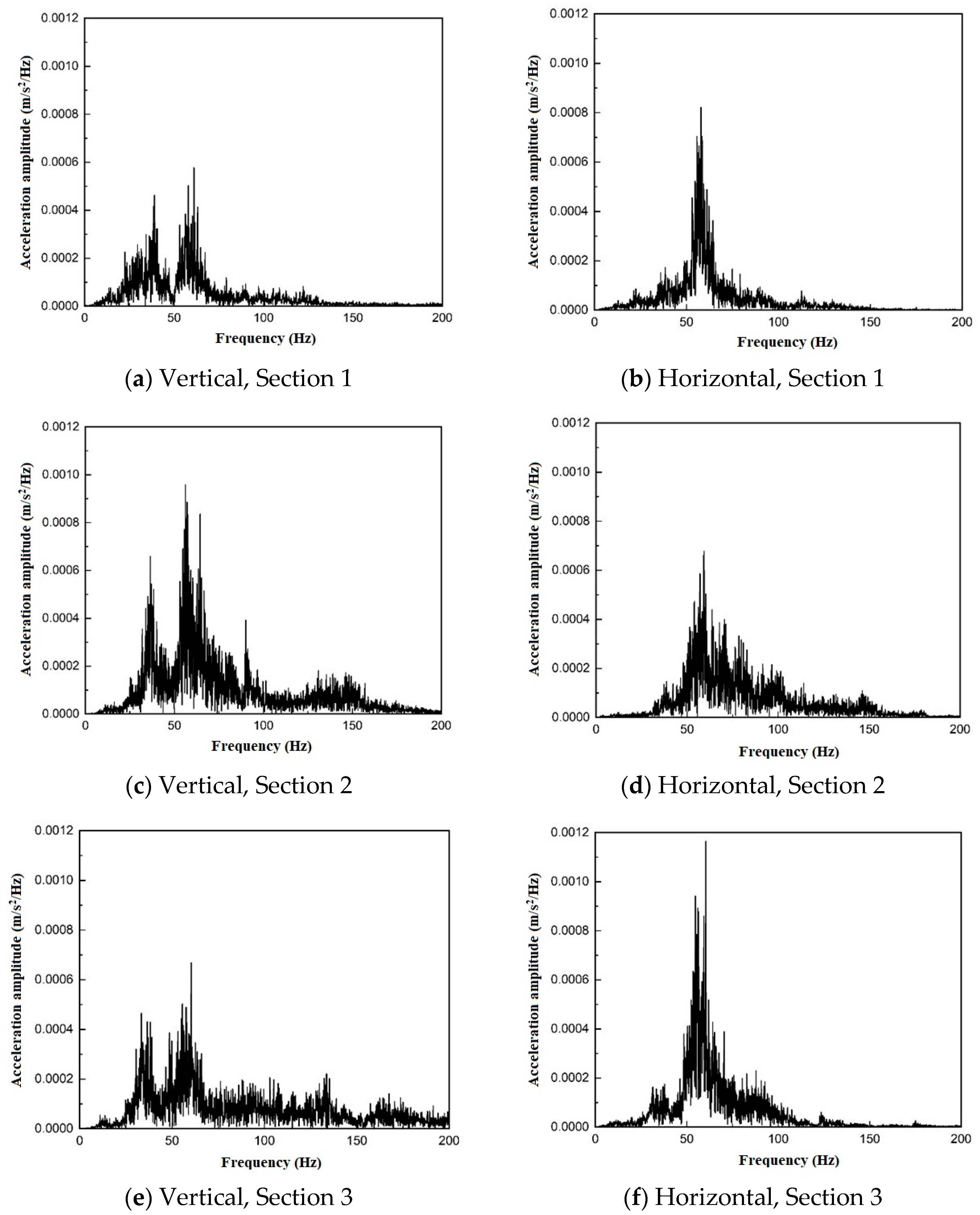
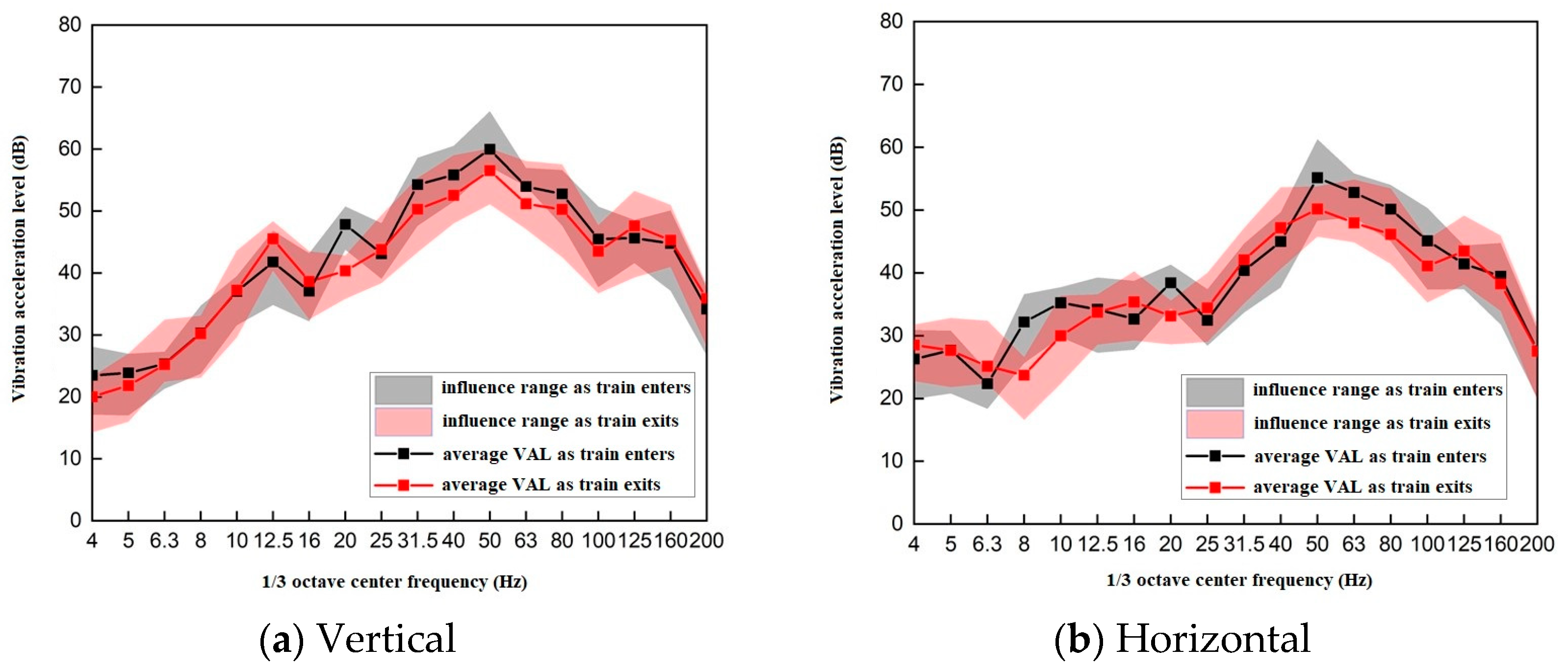
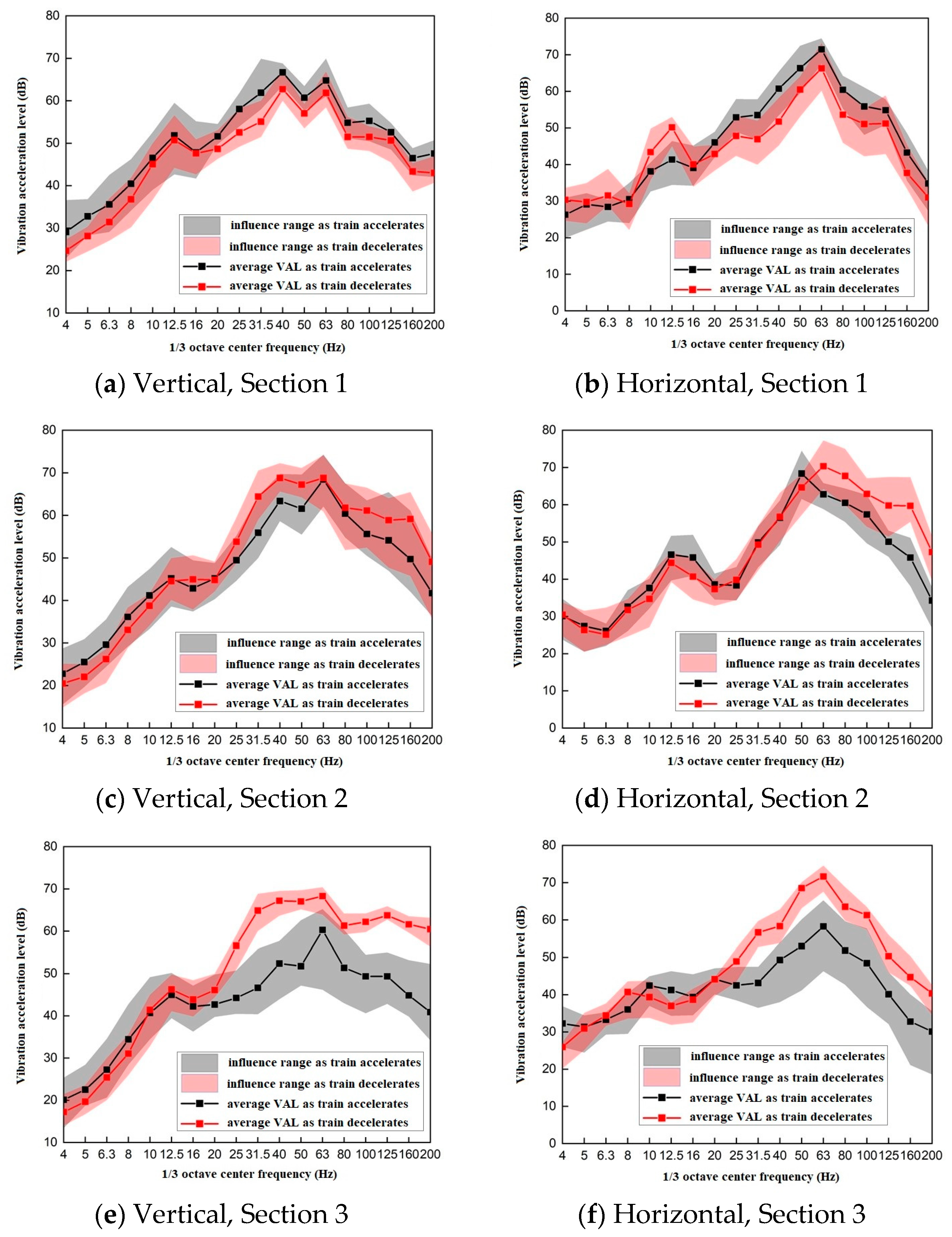
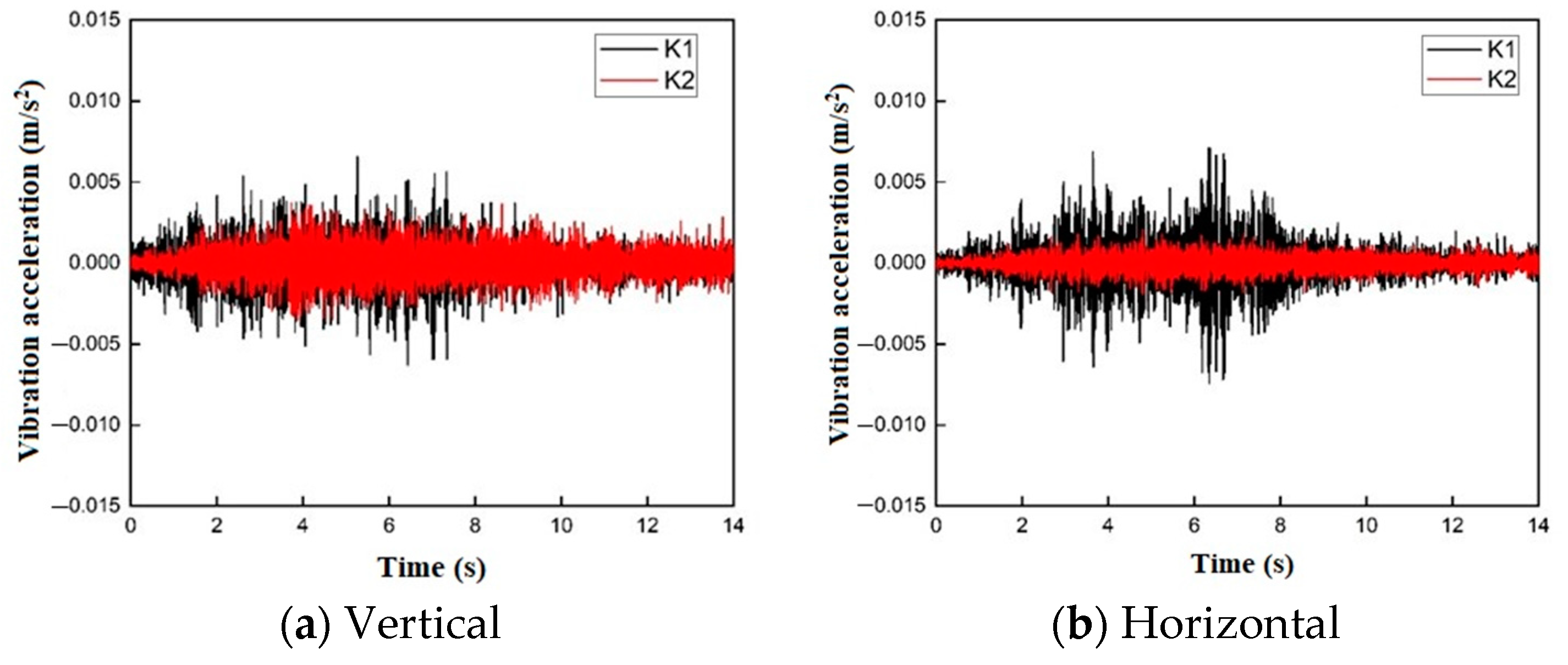
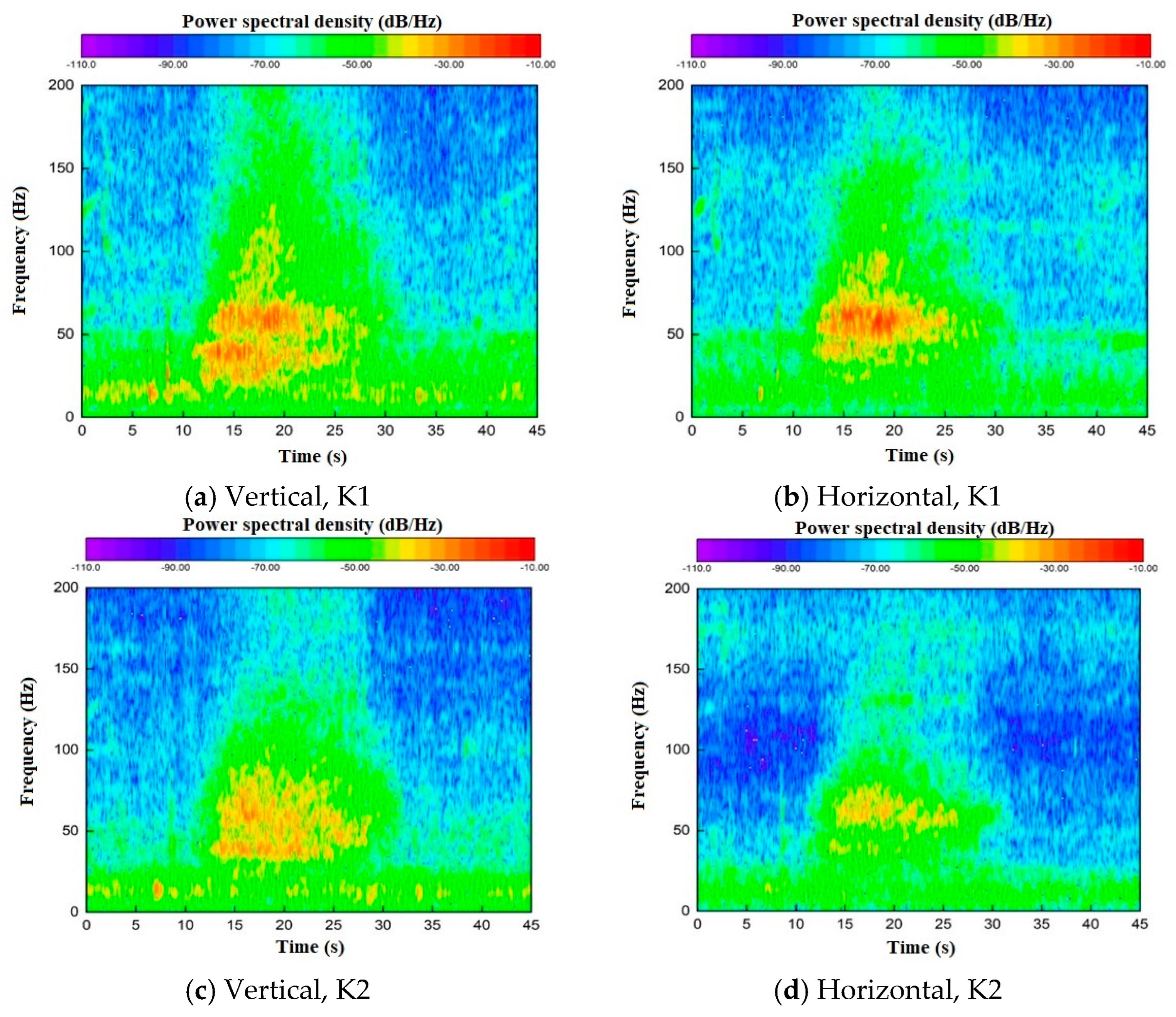

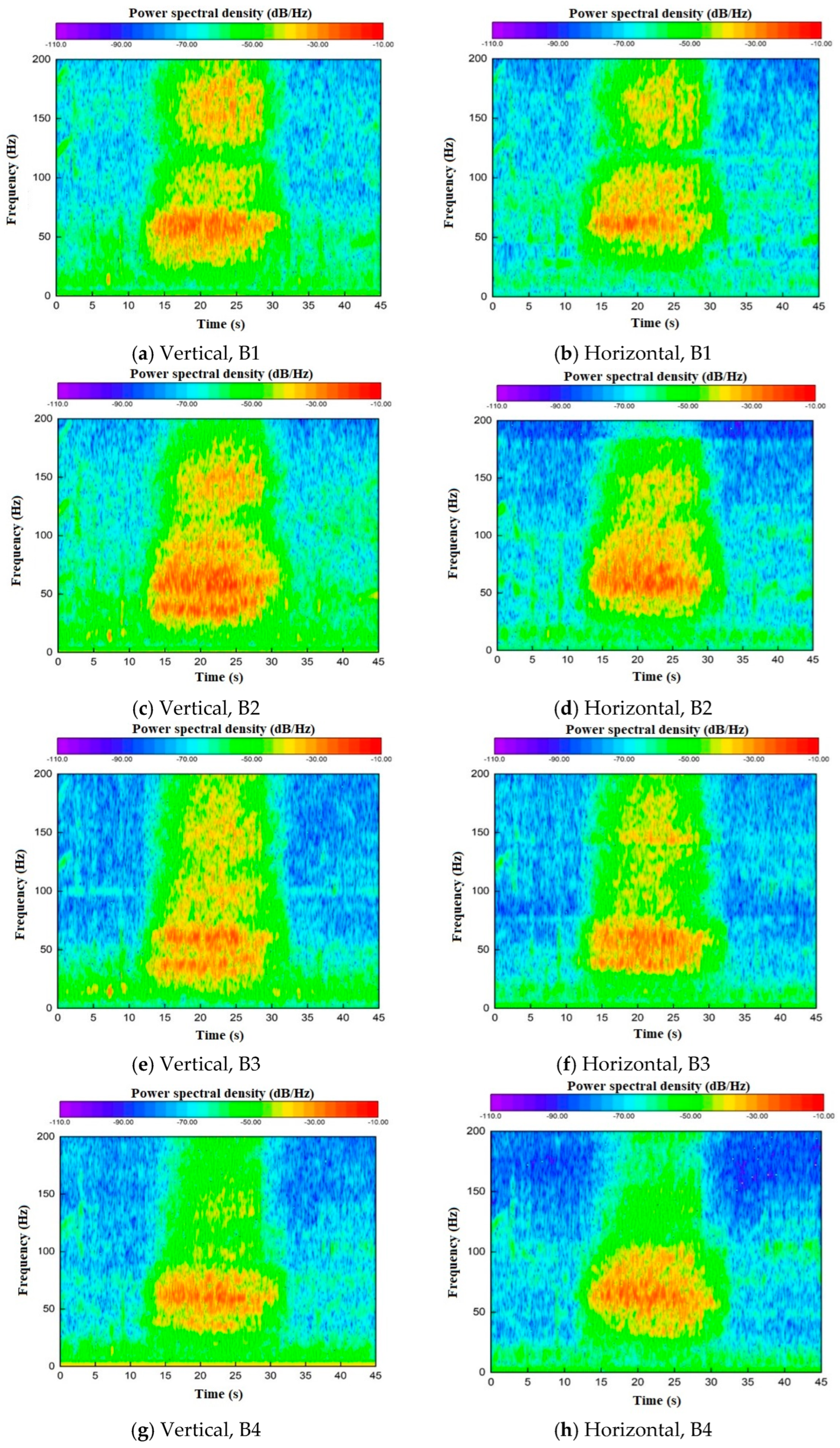
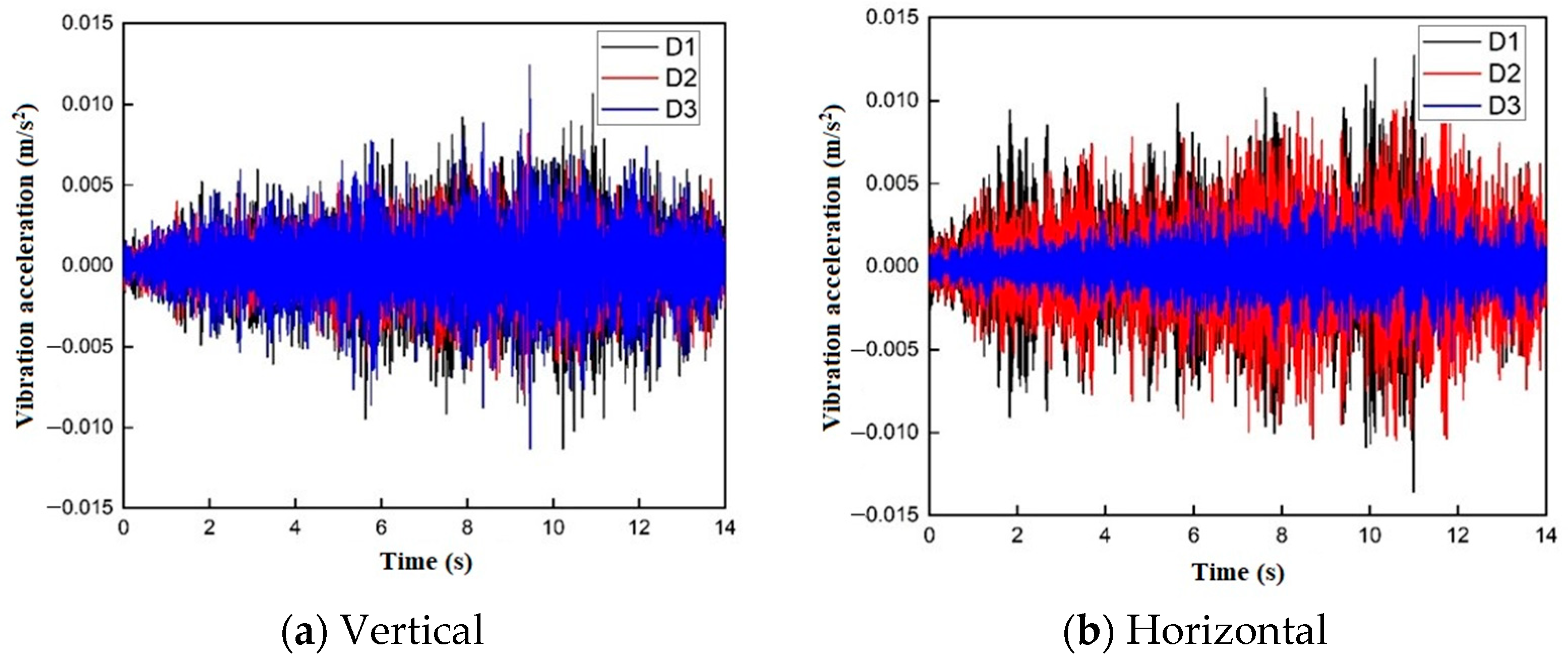

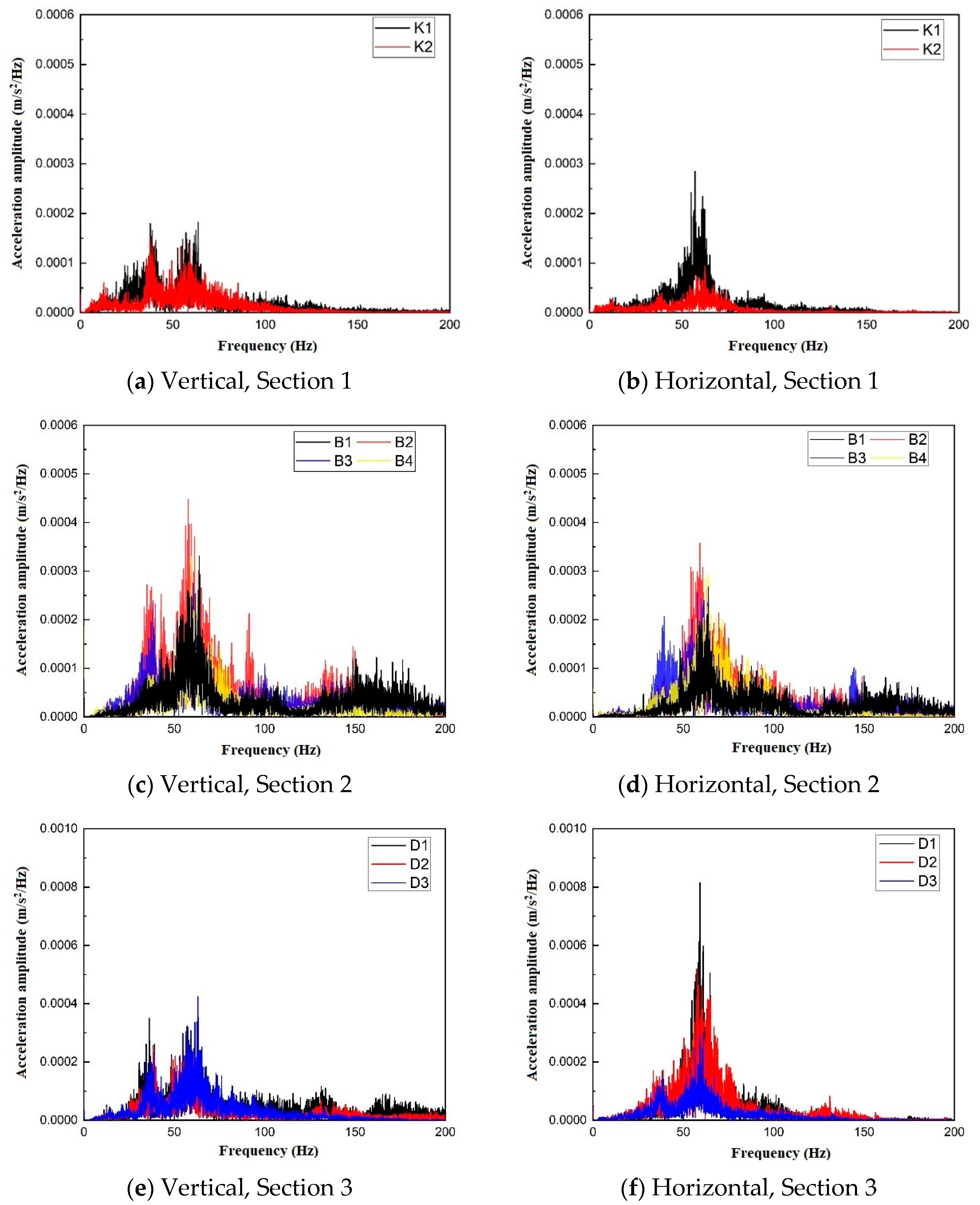

| 1/3 Octave Center Frequency/Hz | Weighting Factor/dB | 1/3 Octave Center Frequency/Hz | Weighting Factor/dB |
|---|---|---|---|
| 4 | 0 | 31.5 | −8 |
| 5 | 0 | 40 | −10 |
| 6.3 | 0 | 50 | −12 |
| 8 | 0 | 63 | −14 |
| 10 | 0 | 80 | −17 |
| 12.5 | −1 | 100 | −21 |
| 16 | −2 | 125 | −25 |
| 20 | −4 | 160 | −30 |
| 25 | −6 | 200 | −36 |
Disclaimer/Publisher’s Note: The statements, opinions and data contained in all publications are solely those of the individual author(s) and contributor(s) and not of MDPI and/or the editor(s). MDPI and/or the editor(s) disclaim responsibility for any injury to people or property resulting from any ideas, methods, instructions or products referred to in the content. |
© 2025 by the authors. Licensee MDPI, Basel, Switzerland. This article is an open access article distributed under the terms and conditions of the Creative Commons Attribution (CC BY) license (https://creativecommons.org/licenses/by/4.0/).
Share and Cite
Shi, Y.; Cai, N.; Chen, Y. Research on the Vibration Propagation Characteristics of Non-Uniform Speed Trains Entering and Leaving Stations Based on Field Measurements. Buildings 2025, 15, 1091. https://doi.org/10.3390/buildings15071091
Shi Y, Cai N, Chen Y. Research on the Vibration Propagation Characteristics of Non-Uniform Speed Trains Entering and Leaving Stations Based on Field Measurements. Buildings. 2025; 15(7):1091. https://doi.org/10.3390/buildings15071091
Chicago/Turabian StyleShi, Ying, Na Cai, and Yekai Chen. 2025. "Research on the Vibration Propagation Characteristics of Non-Uniform Speed Trains Entering and Leaving Stations Based on Field Measurements" Buildings 15, no. 7: 1091. https://doi.org/10.3390/buildings15071091
APA StyleShi, Y., Cai, N., & Chen, Y. (2025). Research on the Vibration Propagation Characteristics of Non-Uniform Speed Trains Entering and Leaving Stations Based on Field Measurements. Buildings, 15(7), 1091. https://doi.org/10.3390/buildings15071091







